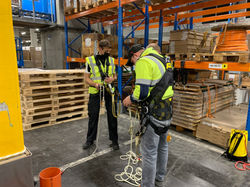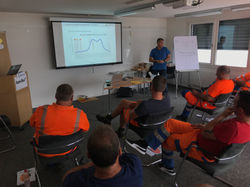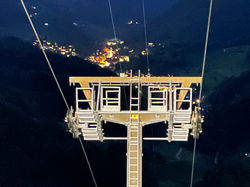
For safe and healthy Jobs
Safe and healthy workplaces require a company safety culture and systematic safety management. Find out where you can get what support.
The law requires employers to systematically identify dangers in the company and take the necessary protective measures in accordance with the recognized rules of technology.
In order to implement these requirements, you need the appropriate know-how and we will support you.
Working with rope protection

Anyone who uses a safety rope and safety harness to protect themselves against falling needs the right material and serious training and education. Improper use of personal fall protection equipment (PPE) can have fatal consequences.
The principle applies that protective measures must be taken if the fall height is more than 2.0 meters.
When is fall protection equipment used?
Priority is given to collective protective devices such as scaffolding, safety nets, railings, aerial work platforms, etc. However, it is not always technically possible to install such devices during construction, assembly, repair and maintenance work. In these cases, personal fall protection equipment must be used.
Working with PSAgA (rope protection) falls under:
“Work with particular risks”. This means that PPEgA may only be used by verifiably trained and trained personnel.
We train your employees according to Suva guidelines.
Training to become an expert in working with PPE
Principles:
-
Collective protection (roofing barriers, safety nets, etc.) has absolute priority. Only use PPE to prevent falls if collective protection is not technically possible.
-
Only allow work with PPE to prevent falls to be carried out by personnel who have been verifiably trained (VUV Art. 5 and 8)
-
The company must use its own resources to ensure that a person who has fallen on the rope is rescued within 10-20 minutes.
Education:
-
Basic training for users of PPE against falls
-
Practice-oriented specialist training (minimum duration 1 day)
For details see Suva Mekblatt 44002
Proof of training:
-
Proof of training must be available upon request
(Duration, date, training facility, trainer, learning content)
Further training / repeat course:
-
Rescuing people who have fallen
-
Planning of anchor devices / project-specific systems
-
Creation of project-specific safety and rescue concepts
-
Expert “Checking PPE against falls”
-
Repeat courses/refresher courses

Working on a hanging rope
Depending on the task, a different level of training in rope access and positioning procedures (SZP) is required:
-
Level 1: Employees
-
Level 2: Team leader SZP
-
Level 3: Project manager SZP
For details see Factsheet from Suva “Working on a hanging rope”
The training courses from IRATA (Great Britain), FISAT (Germany) and ARAA (Austria) are recognized in Switzerland.
If you are planning work that will be carried out on a hanging rope, then contact us. We have staff who meet the requirements necessary for rope access and positioning procedures.
We can also carry out complex insect destruction for you safely and professionally.
If necessary, also with rope access technology.

Shafts, pits and canals
A dangerous atmosphere is often present in shafts, pits and canals. This leads to dangers of poisoning, explosion and suffocation. People who have to climb into shafts, pits and canals and work in them are particularly at risk.
We help you implement the legal measures, so you make a significant contribution to preserving lives and preventing human suffering.
Legal basis
-
General, Art. 82 UVG
-
Personal protective equipment, Art. 5 VUV
-
Information and guidance for employees, Art.6 VUV
-
ventilation, Art. 33 VUV
Guidelines and further information
-
Suva guidelines regarding working in containers and confined spaces, to the PDF
-
Shafts, pits and canals. The most important thing so that you can get back to the top safely, to the PDF
-
Welding in containers and confined spaces. The most important thing for your safety, to the PDF
-
Safe entry and work in shafts, pits and canals, to the PDF
-
Eight vital rules for the maintenance of machines and systems, to the PDF

 |  |  |
|---|---|---|
 |  |  |
 |  |  |
 |  |  |
